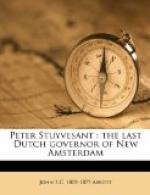In the mean time messengers were sent to all the neighboring chiefs inviting them to come to Esopus to meet “the grand sachem from Manhattan.” Sixty of these plumed warriors were soon assembled, with a few women and children. The governor, with two followers and an interpreter, met them beneath the widespread branches of an aged tree. One of the chiefs opened the interview by a long speech, in which he recounted all the injuries which he conceived that the Indians had experienced from the foreigners. The governor listened patiently. He then replied,
“These events occurred, as you well know, before my time. I am not responsible for them. Has any injury been done you since I came into the country? Your chiefs have asked us, over and over again, to make a settlement among them. We have not had a foot of your land without paying for it. We do not desire to have any more without making you full compensation. Why then have you committed this murder, burned our houses and killed our cattle? And why do you continue to threaten our people?”
There was a long pause, as though the chiefs were meditating upon the answer which should be made. Then one of them rose and, with great deliberation and dignity of manner, said, “You Swannekins,” for that was the name they gave the Dutchmen,
“have sold our children drink. We cannot then control them, or prevent them from fighting. This murder has not been committed by any of our tribe, but by a Minnisinck, who now skulks among the Haverstraws. ’Twas he who fired the two houses and then fled. We have no malice. We do not wish to fight. But we cannot control our young men after you have sold them drink.”
The best of the argument thus far, was manifestly with the Indians. The irascible governor lost his temper. “If any of your young savages,” said he, “want to fight, let them come on. I will place man against man. Nay, I will place twenty against forty of your hotheads. It is not manly to threaten farmers and women and children who are not warriors. If this be not stopped I shall be compelled to retaliate on old and young, women and children. I expect of you that you will repair all damages and seize the murderer if he come among you.
“The Dutch are now to live together in one spot. It is desirable that you should sell us the whole of the Esopus land and move farther into the interior. It is not well for you to reside so near the Swannekins. Their cattle may eat your corn and thus cause fresh disturbance.”
The Council was closed with professions of friendship on both sides. The Indians promised to take the suggestions of the governor into careful consideration. The settlers also decided to adopt the counsel of the governor. They agreed unanimously to form themselves into a village, leaving it with Governor Stuyvesant to select the site. He chose a spot at the bend of the creek, where three bides would be surrounded by water. Two hundred and ten yards of palisades formed the sufficient enclosure.




